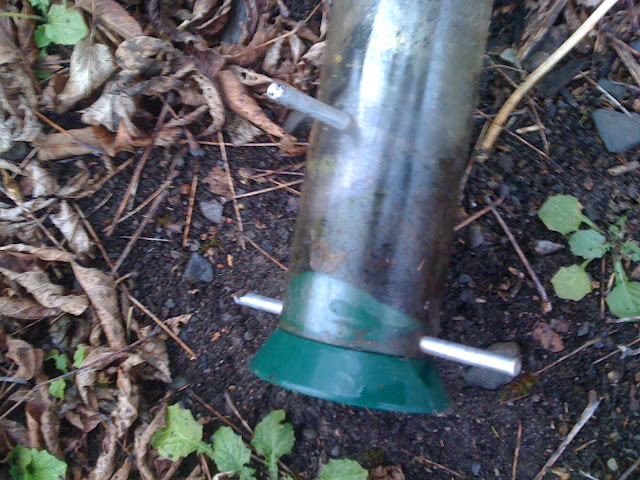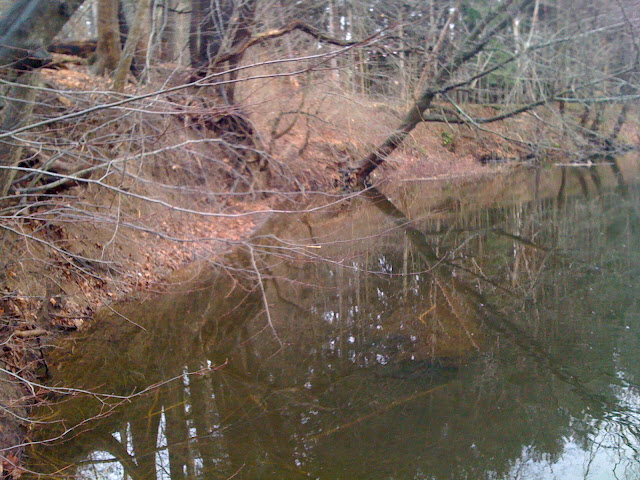If you've followed this blog for a while, you'll notice that something's missing in the picture above. We've had nearly an inch and a half of rain in the past couple of days, and the creek has swollen to a level that I haven't seen before. The dock is covered by about six inches of water, and rising.
 |
| The creek rose to within an inch or two of the lowest step on the dock. |
I knew last night that the dock was in trouble. I heard a steady rain coming down on the roof, and the radar showed a solid area of steady to heavy rainfall moving across the area. The creek was still higher than normal from the inch-plus of rain that fell last weekend, and the ground was relatively moist as well. This pretty much ensured that most of the rain that was falling would find its way, relatively soon, into the creek.
 |
| You can see the steel cable penetrating the water, where it is maintaining a firm hold on the dock. |
A little Flash Flood 101 for you... When rain lands on the grass, it usually percolates into the soil. This process is known as infiltration. But as more rain falls, the pores and interstices in the soil fill with water, and the soil becomes saturated. There are two processes whereby rain will remain on the surface, slowly finding its way to ditches where it becomes ponded or to channels and rivulets where it is slowly (or sometimes quickly, if the surface is sloped) transported into a larger channel - a creek.
 |
| The creek has covered much of the grass on the opposite bank. |
The first of these processes is infiltration excess, which you can think of as a rate excess. The rain is falling faster than the soil can absorb it. This process requires relatively high rainfall rates - probably higher than the ones we experienced during all but the heaviest rains last night - and dominates particularly in arid areas, like the American Southwest. The second process is known as saturation excess, and it occurs when the soil has become saturated, such that it cannot absorb more rainfall...there is simply no more room for water in the soil, so it collects on the surface. My research group has found that saturation excess tends to be more common in the Northeast, particularly in parts of the Catskill Mountains where they have performed extensive studies. Given the soil conditions and rainfall rates last night, it's likely that saturation excess dominated.
 |
| Plants that used to be comfortably on the bank are being swallowed up by the swollen waters. |
We haven't had a steady, constant rain for the past 24 hours, and we haven't experienced any downpours with these precipitation systems comparable to the downpours that fell during thunderstorms in the late summer and early fall, but it's rained long and hard enough to be the most rain that we've experienced since I moved here. Concerned about rain during the day and potentially below-freezing temperatures at night last week, I removed my rain gauge from the backyard so it wouldn't crack. I neglected to put it back yesterday, so I have to rely on other reports to estimate the rainfall. The weather station at Cornell, a few miles away and in an area that was on the fringe of the heaviest rains last night, reported 1.10" of rain through 8 am this morning. Some of the hourly rainfall reports are missing from the Ithaca airport's observations in the early morning hours, so I can't rely on those. I would guess, though, that we had a bit more rain than at Cornell, in the ballpark of 1.25", overnight. But it has continued to rain today, and the rains picked up late this afternoon. The Cornell station has reported an additional 0.19" of rain since 8 am, with most of it falling between 1 pm and now. The Ithaca airport's report for the same timeframe is roughly the same.
 |
| The creek takes up the whole channel as it approaches the dock. |
Every storm, for me, has been a new discovery of how the creek will respond. And today, I was shocked to see how high it had risen. Prior to today, the highest I'd seen the creek was early last week, when it had reached within a couple of inches of the top of the dock. I was prepared to see the water perhaps lapping over the dock, but not to see it submerged by several inches of water. It was also flowing faster than I've seen it.
 |
| The creek is also carrying debris. About 50 yards downstream of the dock, a fallen tree is collecting debris behind it, |
I saw something floating on the water, and I strained to see what it was. At first I thought that it was a log, but as it rotated I saw that it wasn't cylindrical in shape like a log, but rather appeared to have wings, like a bird. If it was a bird, though, it was a relatively large bird. Its body was brownish, and its head appeared to be white....it looked rather like a bald eagle. But by the time I had come to this conclusion, it had floated too far downstream to capture a respectable picture of it. The mystery of the floating bird will have to remain.
 |
| By late this afternoon, the creek was about to completely submerge the lowest step leading to the dock. In the water beyond it, you may be able to make out the faint shadow of the dock itself. |
In the meantime, it's still raining, and the creek is still rising. When I checked on the creek upon arriving home in the waning daylight, it had come up another inch or two, and was now lapping onto the lowest step leading to the dock. Seeing that it was safe, I ventured down there to make sure that the dock was still hanging in there under the surface. I took a photo, and the lighter wood of the dock showed up more clearly than it was visible to my naked eye. I think, despite the tremendous force of all that water, that the dock will hold its ground and still be there after the water recedes in another day or two.
 |
| Looking into the water from the bottom step, you can see the lighter wood of the dock sitting a few inches below the surface. |






















































